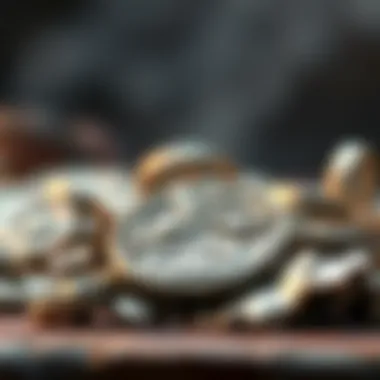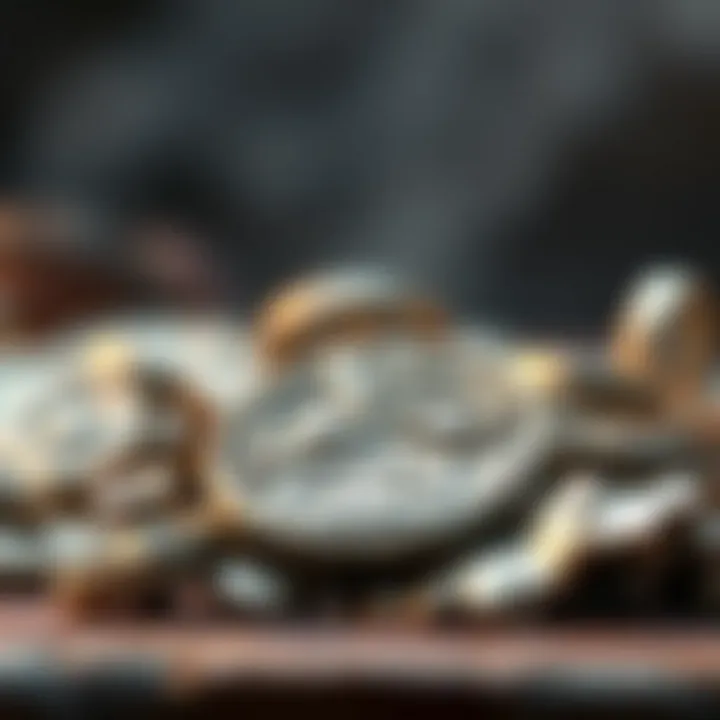Silver as a Commodity: Historical and Market Insights


Intro
Silver has traveled through time as more than just a gleaming metal; it is steeped in history, economics, and industry. Historically, it was as valuable as gold, often used in coins and trade. It has sparked ambitions and shaped economies. But today, silver wears many hats, functioning not only in jewelry and adornments but also as a key player in multiple industries, from electronics to renewable energy.
Understanding silver's role as a commodity requires peeling back layers. Its value doesn’t merely stem from its aesthetic appeal, but from its diverse applications and investment potential. Whether you're an investor just starting out or a seasoned finance professional, grasping the nuances surrounding silver is essential.
This journey into the world of silver will elucidate its past, dissect its various uses today, and forecast its future possibilities. With every twist and turn in the market, keeping a pulse on silver’s trends is crucial for robust investment decisions.
As you delve deeper into this piece, expect to uncover the layers of investment terminology that surround silver, explore expert advice for navigating its market, and understand the dynamics at play. With that, let's turn our attention to the important vocabulary that shapes the dialogue around silver investment.
Prelude to Silver as a Commodity
Silver has long held a seat at the table of valuable commodities, often overshadowed by its glitzy sibling, gold. However, as we dive deeper into the things that make silver unique, it becomes clear that its importance stretches far beyond mere aesthetics or investment potential. Understanding silver as a commodity entails considering its historical significance, diverse applications across industries, and its role in modern-day economics.
From ancient civilizations where silver was used not only as currency but also as an ornamentation in religious practices, to today's tech-driven society where it plays a critical role in electronics and renewable energy, the story of silver is one that intertwines with the evolution of human innovation. Silver’s presence in trade routes echoes through the past, as it facilitated numerous exchanges and cultural interactions. While gold remains the shiny object desired for its wealth symbolism, silver often provides tangible benefits that make it indispensable across various sectors.
Specific Elements of Importance
- Historical Context: Silver isn’t just another shiny mineral; its historical role as money, a medium of trade, and a standard for economies is foundational to understanding its modern-day implications.
- Diverse Applications: Silver's usefulness spans multiple industries. It’s used in everything from conducting electricity to enhancing medical technologies. For example, silver's antibacterial properties make it vital in healthcare settings.
- Investment Viability: From an investment standpoint, silver offers diversification benefits. Investors often view silver as a hedge against inflation and economic instability, which can provide a balance in an investment portfolio dominated by stocks and bonds.
Overall, embracing silver as a commodity means appreciating its multifaceted nature. It’s not just about the market price fluctuations or the latest news updates on trading; it embodies a blend of history, science, and economics that enriches our understanding of this valuable resource. In a world where the future of investments is becoming increasingly digital and volatile, the grounding influence of silver as a physical asset provides both reassurance and opportunity for investors and enthusiasts alike.
"Silver is not just an asset; it's part of our history, a testament to our progress through trade, technology, and artistry."
Through this exploration, we will undertake a journey into the many aspects of silver. This will guide readers toward a richer understanding of why silver deserves more than a passing glance in the realm of commodities.
Historical Context of Silver
Understanding the historical context of silver is crucial for appreciating its role in our economic systems today. Silver has not merely been a metal; it has been a significant factor in shaping trade networks, societies, and economies across the globe. By examining its past, one can glean insights that inform current investment strategies and market behaviors.
Silver in Ancient Civilizations
The journey of silver begins way back in ancient times, where it was more than just currency; it signified power and prosperity. Civilizations such as the Egyptians, Greeks, and Romans recognized the value of silver, shaping it into coins for trade.
"Silver was not merely a commodity but a symbol of balance and commerce."
In ancient Egypt, silver was rarer than gold and often associated with deities. The Greeks forged silver into coins, helping to standardize trade, which allowed merchants and traders to exchange goods without the complex bartering system. In fact, silver coins from ancient Greece, like the Athenian drachma, were so valued that their influence stretched far beyond their borders.
Key Aspects of Silver in Ancient Times:
- Cult Religious Significance: Silver was thought to possess divine qualities, often used in temples and rituals.
- Monetary Standardization: Ancient societies used silver for creating coins, aiding trade and economic stability.
- Symbol of Wealth: Possessing silver was a mark of status and wealth, making it desirable in many cultures.
The Romans elevated silver to unprecedented heights by establishing a vast network of trade routes, thus furthering its spread across continents. Their coins, particularly the denarius, facilitated commerce in a booming economy, influencing trade patterns for centuries.
The Role of Silver in Trade
As societies evolved, so did the role of silver in trade. By the Middle Ages, it became clear that silver wasn't just a commodity but an essential component in the global economy.
Silver served as a backbone for many trade systems. The wealth accumulated by states and empires was often tied directly to their silver reserves, as it allowed nations to control economies through taxation and currency stability.
- Trade Routes: Silver traveled along the Silk Road and across the seas, establishing trade links between distant lands.
- Currency Influence: The Spanish dollar, minted from silver, became synonymous with global trade in the 16th century, facilitating trade across Europe, the Americas, and Asia.
- Economic Drivers: Regions rich in silver, such as Potosí in present-day Bolivia, became economic powerhouses, driving trade with their vast resources.
The significance of silver in trade cannot be overstated. It enabled the growth of economies and influenced geopolitics as nations jockeyed for access to silver mines. The historical importance of silver continues to shape its role in modern markets and investment strategies.
The legacy of silver in these ancient times informs its contemporary status as a valuable commodity, seamlessly bridging historical trade practices with today's investment opportunities. Understanding where silver has been can enhance our grasp of its future potential in a complex global economy.
Physical Properties and Variants of Silver
Understanding the physical properties and variants of silver is crucial, as these factors greatly influence its applications across multiple industries. Silver's unique characteristics contribute to its high demand not just as an investment, but as a material embedded within various technological and medical advancements. Knowing about these properties helps investors and enthusiasts grasp why silver has maintained its value through the ages and how it can fit into portfolios today.
Chemical Properties and Their Implications
Silver, with the symbol Ag, boasts exceptional chemical properties. It is highly malleable, ductile, and possesses a high thermal and electrical conductivity. These attributes are particularly valued in electronics. For instance, silver's conductivity makes it a preferred choice for high-end connections in circuit boards and electronic devices.
One unique chemical characteristic of silver is its resistance to corrosion. However, silver can tarnish when exposed to certain sulfur compounds in the air, dimming its shine over time. This tarnishing is primarily due to the formation of silver sulfide on its surface, which may necessitate cleaning but does not fundamentally alter the metal’s properties or value.
"The luster of silver enhances its aesthetic appeal, making it a favorite among jewelers and designers. But the underlying chemistry really drives its industrial relevance."
In terms of implications for investors, the rarity of high-purity silver can impact its market price. Pure silver, while more valuable in certain contexts, may be less practical for everyday use compared to its alloyed forms, which are designed to enhance specific qualities based on application needs.
Types of Silver: Pure vs. Alloyed
When diving into the topic of silver, it's essential to distinguish between pure and alloyed silver, as these types cater to different needs and markets.
Pure Silver
Also known as fine silver, this type is composed of at least 99.9% silver. Its high purity makes it incredibly lustrous and suitable for various decorative and artistic applications. However, while it shines brightly, fine silver can be more prone to scratching and damage, making it less ideal for daily wear in jewelry compared to its alloyed counterparts.
Alloyed Silver
On the other hand, alloyed silver includes metals such as copper or nickel, which enhance strength and durability. Sterling silver, the most common alloy, contains 92.5% silver and 7.5% of another metal, typically copper. This blend provides a balance of beauty and robustness, perfect for detailed craftsmanship in jewelry as well as everyday household items.
In summary, whether selecting pure or alloyed silver largely depends on the intended use. For investors, understanding the differences can guide purchasing decisions based on market trends and consumer preferences in jewelry and electronics.
In an unstable economic environment, silver stands out, not only for its investment potential but also for its physical properties that support its diverse applications. By keeping an eye on innovations related to both pure and alloyed silver, one can anticipate shifts in market demand that may inform more strategic investment decisions.


Industrial Applications of Silver
The role of silver in various industrial applications extends beyond its aesthetic beauty or historical value. As a highly conductive metal, silver's applications permeate multiple sectors, from electronics to healthcare and renewable energy. This section delves into the different facets of silver's industrial uses, shedding light on both the benefits and considerations involved in its utilization.
Electronics and Conductivity
In the realm of electronics, silver stands as the champion of conductors. Its unparalleled conductivity makes it an invaluable asset in manufacturing a multitude of electronic components. This includes everything from circuit boards to smartphones. With the increasing reliance on technology, especially in areas like communication and computing, silver’s presence is foundational.
"Due to its high electrical conductivity, silver is more effective than copper, leading to its growing use despite higher costs."
- Key Applications: Silver is often used in:
- Circuit boards
- Connectors
- Conductive inks
Acknowledge that while silver's high conductivity ensures efficiency, it also leads to increased costs. Companies weigh the balance between performance and budget constraints. Furthermore, the push for more sustainable practices in electronics raises questions about the ethical sourcing of silver, prompting some enterprises to invest in recyclable materials and practices that could lessen the environmental impact.
Medical Uses and Innovations
Silver's antibacterial properties have rendered it a staple in medical applications. Its effectiveness in curbing infections in various settings—ranging from wound care to surgical instruments—makes it a reliable option for healthcare providers.
Some noteworthy uses include:
- Antimicrobial Dressings: Silver-infused dressings can help heal wounds by minimizing the risk of infection.
- Medical Devices: Several devices, like catheters, incorporate silver to reduce bacterial growth and improve patient outcomes.
The ongoing research into silver's medical applications is fascinating. Innovations in silver nanoparticles demonstrate the potential for enhanced treatments and diagnostics, igniting interest in how this ancient metal could revolutionize modern medicine.
Photovoltaics and Renewable Energy
As the world pivots towards renewable energy solutions, silver has carved out a vital role within the solar power industry. Photovoltaic cells, particularly in solar panels, utilize silver to enhance efficiency and energy conversion rates.
- Why Silver? Silver's high conductivity contributes to:
- Increased efficiency in solar panels
- Improved energy capture in various lighting conditions
Current projections indicate a rise in solar energy production, thus elevating silver's demand in the coming years. However, the mining and production processes must adapt to meet this demand sustainably, promoting a cleaner approach to silver extraction and utilization.
The industrial applications of silver underscore its versatility and importance in advancing not only technology and health but also sustainability. As trends continue to evolve, monitoring the developments in these sectors can provide valuable insights into silver's future as a key commodity.
Silver in Investment Portfolios
Investing in silver as part of an investment portfolio is an important consideration, given its historical resilience and potential for both short-term gains and long-term stability. Silver is often viewed as a hedge against inflation and currency fluctuations. Its intrinsic value and industrial utility make it a unique addition to any asset mix. In this section, we will explore the nuances of including silver in investment portfolios, highlighting specific elements, benefits, and considerations.
Historical Price Trends
Understanding the historical price trends of silver is key for potential investors looking to navigate today’s market. Over the years, silver prices have shown significant volatility; this fact alone can give investors pause. For instance, during periods of economic crisis or uncertainty, such as the 2008 financial meltdown, silver often regained its allure, prompting price surges as investors flocked to safer assets.
From the late 20th century to the present day, price trends illustrate fascinating patterns. Silver’s price hit an all-time high of nearly $49 an ounce in 2011, driven by a mix of speculative trading and rising demand in the tech sector. However, prices have also dipped considerably during times of lower demand, reminding investors that silver, while valuable, does not ensure a one-way ticket to profit.
"Silver, like a double-edged sword, can cut both ways; understanding its pricing history is essential for making informed decisions."
This price fluctuation underlines the necessity of a balanced approach to silver investments. Investors may consider dollar-cost averaging, which involves consistently investing a fixed amount in silver, regardless of its price, to smooth out the volatility. This strategy can help mitigate risks, especially for those new to silver investing.
Silver Compared to Other Precious Metals
When examining silver's role alongside other precious metals such as gold and platinum, several factors come into play. Silver is often regarded as a more accessible investment due to its lower price relative to gold. For those wanting exposure to precious metals without breaking the bank, silver provides a compelling option.
Furthermore, unlike gold, which is largely stored and traded as an investment vehicle, silver's vast industrial applications contribute to its demand. Industries ranging from solar energy to electronics utilize silver, creating a unique intersection between market demand and investment potential. This duality makes silver a valuable asset in a diversified investment portfolio.
Moreover, silver traditionally has a higher correlation with industrial economic activity than gold. Hence, during robust economic growth, silver might outperform gold. Be that as it may, during periods of economic downturn, gold often shines brighter as a safe haven, while silver can lag behind.
Market Dynamics and Pricing Influences
In the complex and ever-shifting landscape of commodities, understanding market dynamics and pricing influences is crucial for anyone interested in silver. The price of silver does not exist in a vacuum; it is shaped by a medley of factors ranging from supply chain issues to global economic health. Grab your metaphorical magnifying glass and delve into this fascinating arena where market forces play a pivotal role in forecasting the commodity's future. By grasping the significant elements of market dynamics, investors gain insights that inform their strategies and enhance their potential for profit.
Supply Chain Factors
When discussing silver's pricing, one cannot overlook the intricacies of the supply chain. Silver mining operations, processing activities, and distribution networks all contribute to the final price that consumers see. The supply chain for silver is multifaceted, often influenced by geographical discrepancies, geopolitical events, and labor relations.
For instance, consider the mines located in Mexico, Peru, and China, which account for a large chunk of silver production. When production in any of these countries faces disruptions, be it due to labor strikes or political instability, the ripples extend through the global market, inevitably pushing prices higher. Modular operations like those seen in the mining sector become critical. Investors should pay attention to:
- Extraction costs: Factors like ore grade and energy expenses directly influence supply.
- Transportation limitations: Any delay affects overall availability in the market.
- Environmental regulations: Stricter regulations may curb mining operations and add costs.
Keeping an eye on these elements makes a world of difference.
Demand Fundamentals
As any investor knows, demand fundamentals can shift within a heartbeat, and silver is no exception. The demand for silver stems from various sectors, including the industrial, photographic, and investment fronts. In recent times, the industrial demand for silver has increased due to technological advancements, particularly in sectors like electronics and renewable energy.
Moreover, the rise of green energy technologies, bolstered by global climate initiatives, is predicted to elevate silver demand significantly. Silver plays a central role in photovoltaics, a critical component of solar panels. Understanding these emerging demand trends enhances a trader’s ability to forecast price movements. Key points to consider include:
- Increasing demand in electronics: Mobile devices and electric vehicles are becoming major consumers.
- Investment purchases: Silver is often regarded as a safe haven asset during economic downturns.
- Cultural uses: From jewelry to silverware, the cultural inclination for silver remains robust.


Desire for silver fluctuates, resulting in price oscillations that astute investors need to monitor closely.
Speculative Trading and Its Impact
The landscape of silver investment is equally influenced by the actions of speculative traders. Think of these traders as the wild cards in a poker game; their movements can create ripples that may alter price trajectories in short time frames. Many engage in buying silver not only as an investment but also for quick profits based on anticipated price movements.
These speculative elements introduce volatility, often making abrupt shifts in price. For example, in times of uncertainty, you'll see a rush toward silver assets, as traders look to hedge against market instability. Important considerations related to speculative trading include:
- Market sentiment: Fear or euphoria can manifest in price swings, driven by trader emotions.
- Volume of trades: An uptick in the trading volume often correlates with spikes in price.
- Media influence: News events can rapidly escalate trading activities, leading to price changes almost overnight.
Investor sentiment can create rapid-fire effects on the price, so keeping one’s ear to the ground for market sentiment is invaluable.
Understanding the interplay of supply, demand, and speculative trading is essential for making informed decisions in the silver market. All these dynamics underscore the robust ties between various market elements that define silver’s liquidity and pricing.
In wrapping up this exploration, it’s clear that the factors influencing silver pricing are interconnected, creating a complex tapestry that investors must navigate. Recognizing the dynamics in play can spell the difference between a good investment and a potentially regrettable decision.
Investment Vehicles for Silver
In the world of finance, investing in commodities like silver is not just a back-alley pursuit; it’s a refined undertaking that demands careful consideration. Understanding investment vehicles for silver is crucial for those eager to harness the metal’s potential, offering various paths one can take. Each vehicle comes with its own set of benefits and drawbacks, and the right choice often depends on individual goals and risk tolerance. This section dives deep into the three main vehicles through which investors can access silver: physical silver, exchange-traded funds, and mining stocks.
Physical Silver: Bullion vs. Coins
When talking about physical silver, two primary forms emerge: bullion and coins. Each holds its own charm and value proposition, appealing to different types of investors.
- Bullion is typically bought in bars, often with a higher degree of purity than coins. These bars can weigh anywhere from 1 ounce to over 1,000 ounces. Investors in bullion are usually focused on the metal's intrinsic value rather than its numismatic value.
- Coins, on the other hand, are minted by governments and usually carry legal tender status. Popular examples include the American Silver Eagle and the Canadian Maple Leaf. While they possess intrinsic silver value, coins can also attract collectors willing to pay a premium beyond the melt value. For many, the allure of coins goes beyond mere investment; it can be a blend of passion and profit.
The decision between bullion and coins isn't solely about aesthetics or investment returns. It also involves considerations on liquidity, storage, and potential capital gains. Investors should choose based on their personal goals, whether looking for a straightforward hedge against inflation or capitalizing on rare finds in coin collecting.
Silver Exchange-Traded Funds (ETFs)
For those who prefer a more hands-off approach, silver ETFs are an enticing option. These funds track the price of silver but don’t require physical storage or insurance, which can be a hassle for direct investors. An ETF can be bought and sold on the stock exchange, providing liquidity and ease of trading, much like any stock.
Among the popular ETFs are the iShares Silver Trust and the Sprott Physical Silver Trust. Both provide investors exposure to silver's price movements without necessitating the physical ownership of the metal. However, it's essential to consider the management fees associated with these funds, as they can vary significantly.
Here are some key points for consideration when investing in silver ETFs:
- Cost Efficiency: ETFs often have lower transaction costs compared to buying physical silver.
- Diversification: They allow investment in multiple silver-based assets without needing to manage them.
- Real-time Trading: Investors can buy and sell throughout the trading day, providing flexibility and immediacy.
Mining Stocks and Their Correlation
Investing in mining stocks represents another vehicle to engage with the silver market. Here, one buys shares of companies involved in silver mining, like Pan American Silver Corporation or First Majestic Silver Corp. The appeal lies in the potential for higher returns compared to investing directly in the metal. Mining stocks often move with the price of silver, but they also carry risks unique to individual companies, including operational issues, geopolitical stresses, and management effectiveness.
Moreover, mining companies can sometimes offer dividends, presenting an additional income stream that physical silver and ETFs do not provide. However, mining stocks can be more volatile, influenced by factors such as production costs, regulatory changes, and market demand.
"Understanding the relationship between silver prices and mining stocks is vital, as not all stocks will rise and fall uniformly with the price of silver."
In summary, choosing how to invest in silver requires an understanding of these vehicles. Physical silver offers tangible value, whereas ETFs provide ease and lower costs. Mining stocks may yield higher returns at the price of added volatility, presenting a mix for investors to weigh carefully. Each vehicle has its merits, aligning differently with personal financial objectives. Making an informed decision will enhance the prospects for success in navigating the silver commodity landscape.
Global Production and Reserves
Understanding the global production and reserves of silver is vital for grasping its significance as a commodity. The varying dynamics of silver production, from extraction methods to geopolitical influences, play an essential role in shaping its market value. This section aims to illuminate these aspects, shedding light on how they affect investors and the overall silver landscape. By examining the leading producers and the geopolitical factors at play, you can gain a clearer picture of what drives silver’s availability and pricing.
Leading Producers of Silver
Silver production is concentrated in a few countries, with global dynamics often defining its supply chain. Mexico, being the largest producer, contributes significantly to the global silver output. The United States, particularly states like Nevada, follows closely behind. Meanwhile, Peru and China also stand out as key players in the silver market.
Here are some notable points about these leading producers:
- Mexico: Often leads global production, its mining industry benefits from rich deposits.
- United States: Strong regulations promote sustainable mining practices, while ensuring a steady supply.
- Peru: With growing production capabilities, it has seen investments bolster its silver mining sector.
- China: Utilizes vast resources and infrastructure but faces environmental scrutiny regarding mining practices.
"Silver mining in these leading countries reflects the intersection of natural resource availability and market demand, highlighting how geographical factors can influence commodity trade."
These nations not only provide silver to the market but also shape its pricing through operational efficiency and political stability. Furthermore, the techniques used in extraction can greatly impact costs and quality, showcasing the importance of investing in modern technology for optimal yield.
Geopolitical Factors Affecting Production
The geopolitical landscape can have profound consequences on silver production. Factors such as political stability, trade policies, and regulatory frameworks all come into play. Here’s how:
- Political Stability: In countries with strong governance systems, silver producers often face fewer disruptions, leading to consistent production levels. For instance, a change in government can lead to shifts in regulations that might affect mining permits or labor laws, directly impacting output.
- Trade Policies: Tariffs and trade agreements can either facilitate or hinder silver export and import. A country implementing favorable trade agreements can enhance its market presence, while tariffs might lead to an increase in costs for investors.
- Environmental Regulations: Stricter environmental laws are becoming increasingly prevalent. While necessary for sustainability, they can limit production capabilities and increase operational costs, forcing producers to adapt swiftly.
Recent tensions among major silver-producing nations can also create an unpredictable market environment. Investors must take these geopolitical factors into account when considering silver for their portfolios, as they may influence supply chains and thus prices in fundamental ways.
Regulatory Framework and Market Oversight
The interaction of regulatory frameworks with market oversight forms the backbone of a well-functioning commodity market. For silver, which boasts a rich historical narrative as a precious metal, these regulations play a pivotal role in shaping market dynamics.
International Standards and Practices
International standards help to set the stage for fair trading practices in silver markets worldwide. Various organizations, such as the International Organization for Standardization (ISO) and the London Bullion Market Association (LBMA), establish norms that govern quality, assay methods, and trading protocols. Adhering to these standards provides a level playing field, ensuring that silver's purity and quality are maintained across borders.
Moreover, transparency is vital in protecting investors from fraud and misleading information. Following international standards assures that all market participants can have confidence in the value and reliability of the silver they buy or sell. The implications of these standards extend beyond mere compliance; they significantly influence pricing and demand in the global silver market, driving investor interest.


Key Aspects of International Standards:
- Assay Protocols: Ensure that the silver's stated purity aligns with what is delivered.
- Trade Insight: Provide guidelines on trading practices that enhance market liquidity.
- Consumer Protection: Safeguard against counterfeit products, instilling consumer and investor confidence.
By incorporating these practices, not only does the silver market benefit, but it also retains its integrity in a rapidly evolving economic landscape.
Investment Risks and Legal Considerations
Investing in silver, much like any other asset class, is accompanied by its share of risks and legal nuances. Understanding these aspects is crucial for any investor who aims to navigate the silver market effectively.
Firstly, market volatility can pose significant risks. Silver prices are heavily influenced by various factors including geopolitical developments, industrial demand, and economic policies. Investors must remain vigilant and aware of these forces that can cause price swings. Additionally, regulations can vary significantly from one jurisdiction to another, potentially impacting how silver is bought, sold, or stored.
Legal Considerations to Weigh:
- Tax Implications: Understanding the tax responsibilities that come with silver investments.
- Import/Export Regulations: Knowing the laws governing cross-border silver transactions to avoid penalties.
- Ownership Rights: Familiarizing oneself with the legal rights attached to physical ownership versus investing through funds or contracts.
Investors should also consider seeking advice from financial advisors or legal experts knowledgeable in commodity regulations to navigate these complexities effectively.
"Being proactive about understanding the regulatory landscape can make all the difference in managing risks associated with silver investments."
Environmental and Ethical Considerations
In recent years, the conversation around silver as a commodity has expanded to include environmental and ethical considerations. As demand for silver grows in industries ranging from technology to renewable energy, we must also ponder its impact on ecosystems and the communities involved in its extraction. Acknowledging these factors is crucial for investors and stakeholders looking to align their practices with sustainable values.
Environmental considerations play a significant role in determining the auto-sustainability of the silver mining industry. Mining operations can lead to deforestation, soil erosion, and pollution of water sources, raising critical questions about the long-term viability of these practices. As investors, ensuring that your silver investments are rooted in a framework that cares for the planet can lead to more informed decisions and possibly greater returns in the future.
Sustainable Mining Practices
Sustainable mining practices are emerging as a vital solution to the environmental challenges posed by silver extraction. This approach to mining focuses on minimizing impact through methods that balance productivity with ecological stewardship.
For instance, companies like First Majestic Silver Corp. emphasize responsible mining that minimizes land disruption and enhances rehabilitation efforts. These efforts are not just about adhering to regulations; they also reflect a growing recognition among stakeholders about the importance of maintaining community health and environmental integrity. In many cases, sustainable practices also lead to cost reductions in the long term, as minimizing waste and energy use can significantly lower operational expenses.
Here are some common sustainable practices in the silver mining industry:
- Water Management: Implementing advanced water recycling techniques reduces freshwater consumption.
- Erosion Control: Planting vegetation around mining sites helps to stabilize soil.
- Benchmarking Energy Use: Companies are working to lower their carbon footprints by investing in renewable energy sources.
- Community Engagement: Establishing dialogue with local communities ensures the sharing of benefits and reduces conflicts arising from mining activities.
"Sustainable mining practices are not only good for the planet but can also enhance the long-term profitability of mining ventures."
Recycling Silver: An Emerging Paradigm
Recycling is increasingly viewed as an effective strategy to mitigate the environmental impacts of silver mining. With silver’s high value, the recovery of precious metals from old electronics, jewelry, and industrial waste represents a sustainable alternative to traditional mining. This paradigm shift is gaining momentum as technology and awareness about sustainable practices unfold.
The process of recycling silver is efficient and significantly less harmful to the environment than extracting it from the earth. The recycling process typically includes recovery from:
- Electronic Waste: Many electronic devices contain silver, making the recycling of aged gadgets like smartphones valuable.
- Jewelry Scraps: Gold and silver jewelers have begun emphasizing the importance of recycling old jewelry, often offering discounts in return for customers' unused items.
- Photographic Materials: Though less common, materials from the photography industry, which contain silver, are recycled effectively.
Aside from reducing environmental impact, recycling silver can help stabilize market prices. As the extraction of raw silver becomes increasingly expensive and fraught with regulatory barriers, the growth in recycled silver supply can ease market tensions. Companies focusing on recycling can provide a steady supply chain and tap into an emerging market of ethically sourced materials—a strong selling point to environmentally conscious consumers and investors.
For further insights on ethical mining and silver recycling, consider visiting Wikipedia, or dive into discussions on Reddit about investors’ perspectives on commodities.
Future Outlook for Silver as a Commodity
The future of silver as a commodity holds substantial significance for investors and industry stakeholders alike. As a precious metal with both intrinsic value and wide-ranging applications in various sectors, silver's trajectory is influenced by economic indicators, geopolitical tensions, and advancements in technology. Understanding these elements is crucial for making informed decisions in an ever-changing market.
Emerging Market Trends
Emerging market trends paint a lively picture for silver in the coming years. The increasing demand from photovoltaic industries reflects a global shift towards renewable energy sources. Solar panels, which utilize silver for their conductive properties, are likely to see continued growth in production.
- Renewable Energy Demand: The push for greener solutions and the decarbonization of economies contribute significantly to silver's potential. Countries investing heavily in solar energy will likely spur demand for silver, casting it as a critical player in renewable energy.
- Consumer Electronics: With the advancement of 5G technology and a rise in electronic consumption, silver is becoming integral in smart devices, reflecting a gradual change in consumer behavior towards interconnected devices.
- Investment Popularity: As inflation concerns rise and stock markets exhibit volatility, investors often turn to silver as a safer investment alternative. This trend presents strong potential for silver's appreciation in value.
"Silver is more than just a shiny asset; it’s a barometer for both modern technology growth and traditional investment strategies."
Technological Advancements and Their Effects
Technological advancements are reshaping the future landscape of silver, particularly in industrial applications. Here are a few notable areas where technology plays a pivotal role:
- Nanotechnology: Innovations in nanotechnology are leading to new uses for silver, particularly in electronics and medical industries. Silver nanoparticles have a range of applications, such as antimicrobial coatings and advanced batteries, which may boost future demand.
- Direct Printing & Manufacturing: The rise of direct printing technologies allows for more efficient uses of silver, reducing waste and optimizing production processes. This trend not only makes silver applications more economical but also expands its potential uses in various sectors.
- Mining Technologies: Advances in mining technology enhance the efficiency of silver extraction, making previously unviable deposits profitable. This shift can lead to increased supply and ultimately impact pricing in the market.
In summary, as technological innovations continue to evolve, they help shape a promising future for silver as a commodity. The interplay between emerging market trends and advancements in technology underscores silver’s multifaceted role within both industrial and investment arenas.
Closure
As we draw the curtains on our exploration of silver as a commodity, it’s vital to recognize just how intricate and crucial this metal is to both history and modern society. Throughout the pages of this article, we've traversed the historical significance of silver, from ancient trade routes to its steadfast role in contemporary investment strategies.
One of the standout points is silver's versatility. The industrial applications alone—from electronics to medical technologies—underscore its importance beyond mere aesthetics or investment potential. Investors, in particular, should appreciate silver not just as a static asset but as a dynamic component of market fundamentals that can respond to varying demands and global events.
Moreover, the balance of supply and demand plays a significant role in determining silver’s market price, subject to the ebbs and flows of geopolitical circumstances. As we noted in the previous sections, factors such as mining practices and recycling methods also raise questions about sustainability, reminding us that our choices reverberate beyond just profit margins.
Looking ahead, understanding the future outlook for silver involves keeping an eye on emerging technologies and market shifts, which could radically reshape its role in both industry and investment portfolios. With more investors looking to hedge against inflation and uncertain economic climates, silver's appeal may transition further into mainstream financial tools.
To sum it up, successful engagement with silver requires a comprehensive understanding of its myriad dimensions. Whether one approaches it as a collector, an investor, or simply a curious enthusiast, the knowledge we've laid out provides a solid base. With this understanding, individuals can navigate the complexities of silver trading and investment more confidently, making educated decisions that align with their goals and values.
"Investing in silver isn’t just a choice; it’s a reflection of one’s view on the global economic landscape."
For further reading and resources, one might explore information at Wikipedia on Silver or delve into investment analysis discussions on platforms like Reddit and financial guidelines on Investopedia.
In essence, silver's journey as a commodity is ongoing, and understanding its past, present, and potential future creates not only informed investors but also modern-day stewards of this ageless metal.















